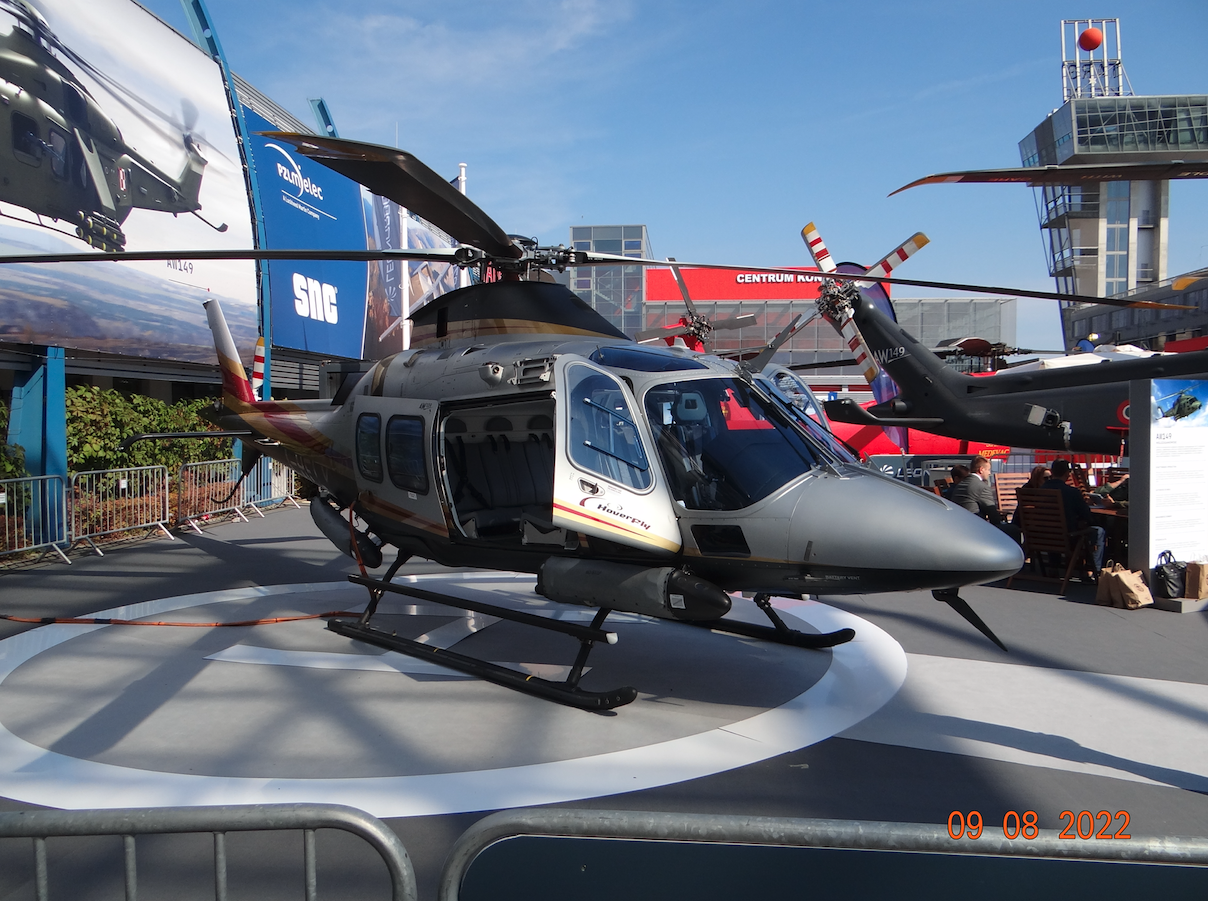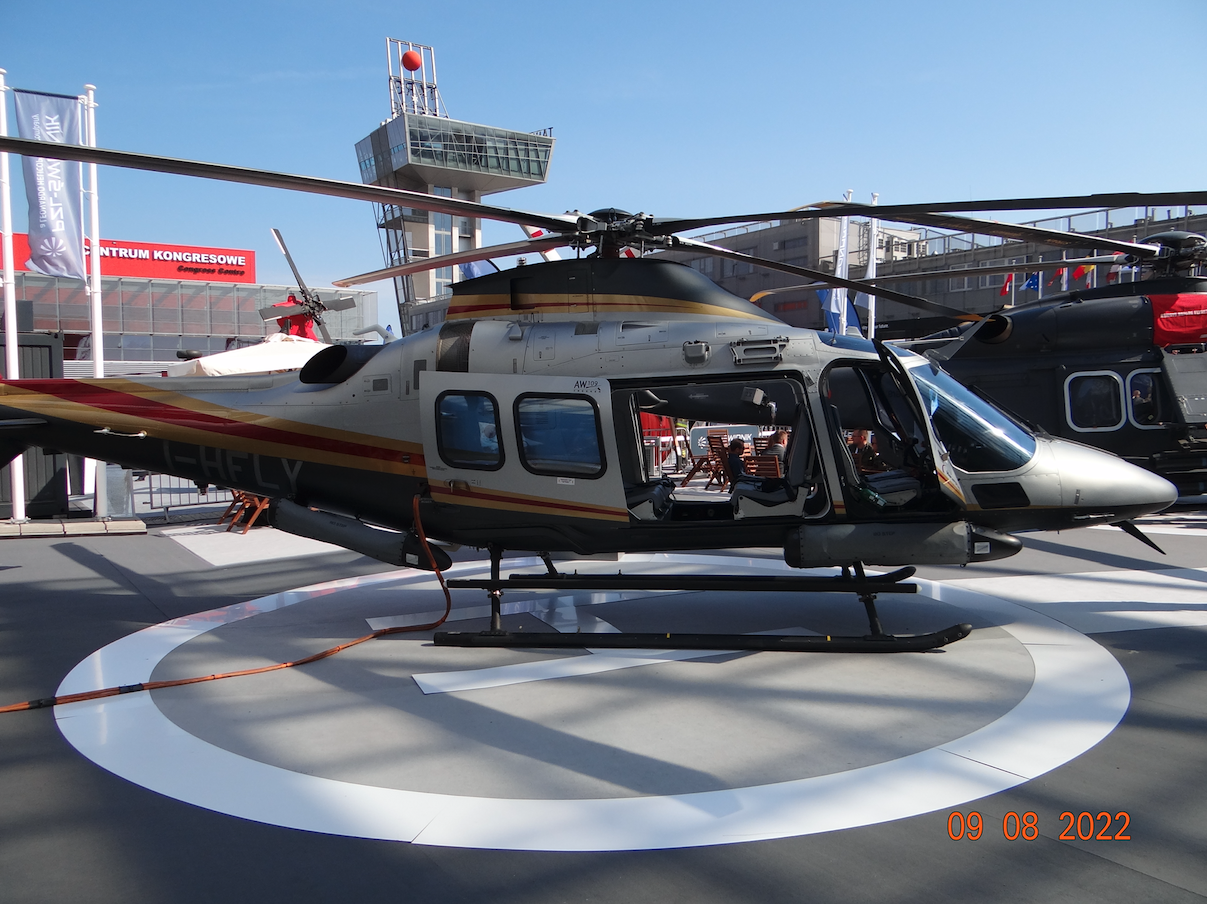Kraków 2005-06-08
315a Tally 2005 rok.
AgustaWestland A.109 / AW.109.
AW-109 helicopter in Poland.
History
The beginnings of the Italian Agusta factory date back to 1907. It was then that the Italian constructor Giovanni Agusta founded a company producing airplanes of his own design. The Great World War disrupted the company’s operations. Production was resumed in 1923. The company then adopted the new name Costruzioni Aeronautiche Agusta S.p.a. The plant was then located in Samarate in Lombardy in northern Italy. The most ambitious program of the company was the four-engine Agusta A.Z.8 plane, intended, among others, to carry 26 passengers. The plane made its first flight on June 9, 1958. The plane looks like the Douglas DC-4 plane. But the company did not receive a single order.
However, as early as 1952, the Agusta company purchased a license from the American Bell 47 helicopter. This decision influenced a change in the production profile. Companies in business have come closer to each other. The cooperation of Agusta and Bell companies in many studies and programs has been carried out until now (2018).
Agusta helicopters have traditionally been marked with the letter "A" and a three-digit number. The first was the A.101 helicopter, which can take 35 passengers on board. The company also dealt with the production of turbine drives for its products. In 1961, Agusta purchased a license for another Bella product, the Bell UH-1 Huey helicopter. In 1967, licenses for the production of the Sikorsky SH-3 Sea King helicopters appeared, produced in several versions, and in 1967, a license for the production of the Boeing CH-47 was purchased.
In 1971, the company built its most recognizable helicopter, designated A.109. In 1983, the first attack helicopter with the designation Agusta A.129 Mangusta was flown. In 1983, the company acquired the Italian aircraft manufacturer SIAI-Marchetti.
Close cooperation between Augusta and the British Westland Helicopters company dates back to the beginning of the 1980s. The first joint project was the AgustaWestland AW.101 helicopter, which replaced the Sea Kinga helicopter. Cooperation was also initiated with other companies in Western Europe.
In 1992, all of these companies formed the NHIndustries consortium in which Agusta had a stake. The result of the work was the NHI NH90 helicopter. In 1998, the company together with Bell Helicopter Textron established a joint venture known as Bell / Agusta Aerospace Company. The product of this cooperation is the vertical take-off and landing (VTOL), Bell / Agusta BA609, predecessor of the V-22. In 2001, Agusta merged with British Westland Helicopters and the new company AgustaWestland was established, which has approximately 20% of the global helicopter market. To date, about 20 types of helicopters have been created, designed to perform various tasks.
Polish participation in Agusta.
WSK PZL Świdnik, looking for orders in order not to liquidate the plant, in 1996 concluded an agreement with Agusta for the production of structural elements of Agusta A.109 helicopters (currently AgustaWestland AW.109) in Świdnik. Production of helicopter hulls and tail beams began in Świdnik. In 2006, the 500 A.109 hull was delivered from Świdnik. In 2001, the cooperation was extended to the production of the hull for the Agusta A.119 Koala model (now AgustaWestland AW.119). Świdnik had a large share in the design and production of AgustaWestland AW.139. Since 2012, complete hulls for the AW.139 model have been manufactured in Świdnik. At that time, talks were also held about the production of elements for the AW.149 helicopter, if its production was undertaken.
Agusta A.109 / AgustaWestland AW.109.
The A.109 helicopter is the only proprietary construction of Agusta. The prototype A.109 nb NC 7101 made the first flight on August 4, 1971. The helicopter obtained RAI and FAA certificates on June 1, 1975. At the same time, the A.109 helicopter was approved for instrument flights with one-man crew. A few months later, the A.109 helicopter was certified by: France, Canada, Germany, Sweden, Switzerland and the UK.
The Agusta company offered the A.109 helicopter in the following versions: civilian, land forces, and naval aviation. The civilian version of the helicopter was offered as a fast VIP transport, as well as for state services: sanitary, police and border guards.
The first serial helicopters were delivered to customers at the beginning of 1976. More than half of the helicopter production was exported to the USA. In Italy, A.109 helicopters went to the traffic police and carabinieri. Many helicopters were delivered to Africa and Asia. At the beginning of the 1980s, the A.109 helicopter was modernized. In the following years, the helicopter was modernized to meet the changing needs of customers. The helicopter was and is offered either with a retractable wheeled undercarriage or with a skid undercarriage. The A.109 K helicopter is a military version, adapted to operate in hot climates. The prototype A.109 K made its first flight in March 1983. The A.109 X Mk II Widebody helicopter has an enlarged fuselage that is wider. The helicopter made its first flight in September 1984.
The A.109 helicopter in Poland. year 2005.
The A.109 helicopter in the sanitary version was purchased by the Polish Medical Air Rescue in Warsaw. Helicopter A.109 No. 11630 received registration SP-HXA and received radio code Ratownik 12. It was in use from July 2, 2005. It was based at the Bemowo-Babice Airport. On November 20, 2009, the helicopter had an accident. The helicopter crew practiced auto-rotation emergency landing. The permissible load on the main rotor blades was exceeded, and as a result, the blade hit the tail beam of the helicopter and destroyed it. The crew, two pilots, did not take much damage.
In the following years, AgustaWestland, and especially the PZL-Świdnik plant, which belongs to the Leonardo concern, offer the AW.109 helicopter in various versions to various Polish companies and services; the army. border guards, police, military police. In April 2022, the AW.109 helicopter of the Polish Border Guard was offered. The bidder, emphasizing the helicopter’s capabilities, mentions: the highest cruising speed in the class, the lowest fuel consumption in the class, spacious cabin, the possibility of installing any specialist equipment [for example, the TFO (Tactical Fly Officer) operator station]. The following can be mounted on the helicopter’s hull: searchlight, optoelectronic head, radar antenna, winch. All this with the possibility of taking five mission officers on board.
Access to the helicopter is possible through four doors. The front is hinged for pilots, and for the holds, they are sliding, which are as much as 1.40 m wide. The floor of the hold is so long that you can lay two sick people on a stretcher on it. The helicopter can operate day and night. The cockpit is of the glass type. The appearance of the AW.109 helicopter is still modern, even though it was developed in 1971.
Written by Karol Placha Hetman


